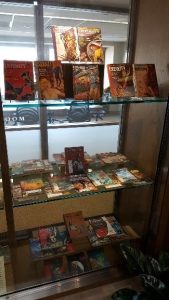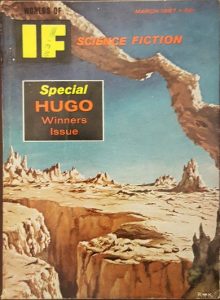[Posted by Ashley Esposito, a graduate student in American Studies doing an internship in the Watkinson]
 As progress continues on this collection, I have switched gears. Individual cleaning and air drying of each volume has proven to be a time consuming endeavor.
As progress continues on this collection, I have switched gears. Individual cleaning and air drying of each volume has proven to be a time consuming endeavor.
This gear change allowed me to plow through five bankers’ boxes of materials in the same time I was able to work on two boxes. With the extra time I was able to focus on the categorizing and sequencing the numerous volumes. Occasionally a duplicate volume was located and the even rarer third copy of a volume.
One unexpected find that I found very interesting was the way that some volumes were marked for postal delivery. In more recent titles the practice of placing the addressee label directly on the magazine publication seems to have become more common. However, I found a few that were still in their original brown paper postal wrapping. According to the US Postal Service at about.usps.com under their Postage Rates for Periodicals: A Narrative History page, periodicals were given a very low rate in the interest of free press that was supported by both Thomas Jefferson and George Washington. This explains the second class marking that seems to have gone out of existence in the modern postage rate schedule.
For me it is easy to see why this collection will appeal to a diverse group of researchers. A researcher could easily look at the printing/binding process of mass publications over the course of many years or the advertisements that find their way into the different magazines or the correlation between pop culture and science fiction predictions. No matter which lens you use, this collection provides a phenomenal look into the past.
[A WEEK LATER]
 This amazing collection has begun to take shape. This week saw huge strides in the organization and chronological order of this overwhelming set of science fiction magazines. To accomplish this task, it was necessary to sort the magazines by title then by decade, year, then finally by calendar year. It was absolutely amazing to see such a diverse set of images and see the progression of each magazine over the years.
This amazing collection has begun to take shape. This week saw huge strides in the organization and chronological order of this overwhelming set of science fiction magazines. To accomplish this task, it was necessary to sort the magazines by title then by decade, year, then finally by calendar year. It was absolutely amazing to see such a diverse set of images and see the progression of each magazine over the years.
Thus far the majority of the magazines are from the following publications; Analog/Astounding Science Fiction, Galaxy, The Magazine of Fantasy & Science Fiction, and Worlds of If Science Fiction. Analog/Astounding Science Fiction now commonly called ASF has been in publication since the 1930’s. Astounding Science Fiction was combined with Analog in the 1960’s and is publishing.
Galaxy was published from the 1950s-1995 in paper and is now in digital format. The Magazine of Fantasy & Science Fiction began its publications about 1949 and is still in publication. Worlds of If Science Fiction also began its publications about 1949 and is still published.
If you are interested in the ins and outs of the publication dates and history of the magazines, I found lots of information from www.sf-encyclopedia.com to be very enlightening. Approximately fifteen to twenty percent of the collection still needs to be sorted but for now it is on display in the atrium of the Raether LITC, near the circulation desk (Level A). Feel free to stop by and look at the wonder that is this remarkable collection.


Comments Off on Piles of scifi!
[Posted by Jennifer Sharp M’11, a Project Archivist with the Watkinson Library]
 A few months ago the Watkinson was fortunate to receive the papers of Charles P. Wells. The image shows the contents of one of the boxes of material when I started working on it. Now, after an initial pass through the entire collection, all the papers have been unfolded and placed in folders.
A few months ago the Watkinson was fortunate to receive the papers of Charles P. Wells. The image shows the contents of one of the boxes of material when I started working on it. Now, after an initial pass through the entire collection, all the papers have been unfolded and placed in folders.
Objects that came with the collection are currently in a separate box.
The next task is to make sure the papers are organized in a way that will make sense to researchers, and will help them find information that is pertinent to their work. What seems to make the most sense is to group them in three series: personal papers, business papers, and papers pertaining to the extended Wells family.
After all the papers have been organized, I will put together a guide to the collection. Called a finding aid, it is like a table of contents for the collection. This will be available online, and anyone who would like to study Charles P. Wells will be welcome to research the collection.
Over the course of the next few posts, I will detail some of the items in the collection to give you an understanding as to what is available, and what you can learn about Wells and his life here in Hartford.


Comments Off on Processing the Papers of Charles P. Wells
 [Posted by Ashley Esposito, a graduate student in American Studies doing an internship in the Watkinson]
[Posted by Ashley Esposito, a graduate student in American Studies doing an internship in the Watkinson]
Leigh Couch Collection in progress…
I am beginning to see an emerging pattern of common imagery and themes. Imagery that persist within science fiction to this day. Isolation of stranded individuals. Most often this isolation seems to be geographic. Wide open spaces and what appears to be conventionally recognized waste land. Often it seems to be reminiscent of the wild west or dessert. With gigantic arching stone formations and a distinct lack of anything visible beyond the landscape.
Another common theme is the imbalance of technology. As seen in this August 1967 cover of The World of If Science Fiction, depicting the concepts from the novel The Age of Science and Sorcery. A bearded man that likely represents a Merlin type character is surrounded by technology. The argument of science versus science fiction has been made many times over the years. I doubt that either will win but the conversation is worth having.
The third common theme was the contrast of humans shown as uncivilized man in a stark contrast to the machines and technology that around them. Very often I found that the cover art pitted the native man against well evolved machines. The common static representation of a sword wielding man fighting against what appears to be far superior technology.
One of the best things about Science Fiction is its ability to move you past your own circumstances. Yet is maintains that same challenges we face in a different light. Escape and storytelling woven together.


Comments Off on SciFi imagery themes
[Posted by Ashley Esposito, a graduate student in American Studies doing an internship in the Watkinson]
 Leigh Couch Collection in progress…
Leigh Couch Collection in progress…
I have been a fan of contemporary science fiction and comic movies/series. Yet my love for written works and reading is relatively new in comparison. So when I was offered the opportunity to work on the Leigh Couch Collection of science fiction magazines at the Watkinson, I was a bit overwhelmed. As part of this project, I will clean, categorize, and inventory this collection while trying not to get too distracted by its content. That is likely to be easier said than done.
The collection is approximately twenty-five standard banker boxes with neatly stacked volumes that are grouped and wrapped in plastic. They were stored in a barn so have varying conditions. Although it is a work in progress and will continue to be for many weeks, I am already beginning to discover hidden treasures.
 The work is slow and repetitive but seeing my first 120 volumes air drying was worth it. So far I have found at least three covers that remind me of favorite contemporary works, diverse images that speak to the duality of science fiction and their fans and even a cover that appears to be printed to be viewed with 3-D glasses. I will let you know how that works out once my newly purchased 3-D glasses arrive in the mail for me to view the cover again.
The work is slow and repetitive but seeing my first 120 volumes air drying was worth it. So far I have found at least three covers that remind me of favorite contemporary works, diverse images that speak to the duality of science fiction and their fans and even a cover that appears to be printed to be viewed with 3-D glasses. I will let you know how that works out once my newly purchased 3-D glasses arrive in the mail for me to view the cover again.
 I have barely scratched the surface of this generous donated collection and have found more than a few ways to let my mind wander and enjoy. That is really what science fiction is about for me. As Robert Frost wrote; “Two roads diverged in a wood and I took the one less traveled and that has made all the difference.” Here is to the less traveled road.
I have barely scratched the surface of this generous donated collection and have found more than a few ways to let my mind wander and enjoy. That is really what science fiction is about for me. As Robert Frost wrote; “Two roads diverged in a wood and I took the one less traveled and that has made all the difference.” Here is to the less traveled road.
Comments Off on Going boldly
 A few months ago the Watkinson was fortunate to receive the papers of Charles P. Wells. The image shows the contents of one of the boxes of material when I started working on it. Now, after an initial pass through the entire collection, all the papers have been unfolded and placed in folders.
A few months ago the Watkinson was fortunate to receive the papers of Charles P. Wells. The image shows the contents of one of the boxes of material when I started working on it. Now, after an initial pass through the entire collection, all the papers have been unfolded and placed in folders.










